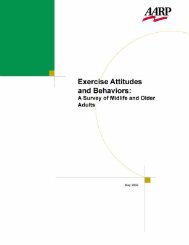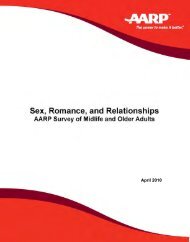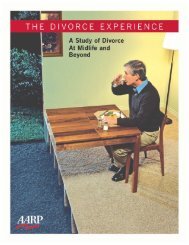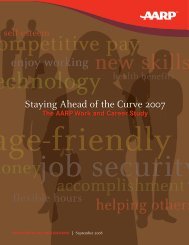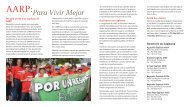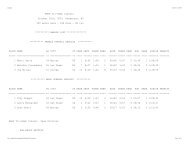The New Aging Enterprise - aarp
The New Aging Enterprise - aarp
The New Aging Enterprise - aarp
You also want an ePaper? Increase the reach of your titles
YUMPU automatically turns print PDFs into web optimized ePapers that Google loves.
Policy Perspective. For increasing numbers of Americans, company pensions are<br />
disappearing. According to the Pension Benefit Guaranty Corporation, the total number of<br />
private-sector pension plans fell by nearly half over the past decade. Today, only one in five<br />
private-sector employees are covered by them. In 1980, among private sector workers with<br />
pension coverage, 60% had a defined benefit plan only, while 17% had a defined contribution<br />
plan only and 23% both. But by 2004, those proportions had shifted dramatically: 11% of<br />
private-sector workers with pension coverage have a defined benefit plan only, 61% a defined<br />
contribution plan only and 28% both. 64<br />
With disappearing defined benefit plans, workers will need to rely more on personal<br />
savings and manage their investments in an intelligent way. On the positive side, public policy<br />
can take steps to expand access to worker retirement savings plans. A study by Hewitt<br />
Associates showed that of the 2.6 million U.S. employees Hewitt analyzed, more than 90% of<br />
workers participated in a 401(k) plan if their company automatically enrolled them, compared<br />
with 68% for employees at companies without automatic enrollment. <strong>The</strong> increase, in short, is<br />
dramatic. <strong>The</strong> Pension Protection Act of 2006 encourages companies to adopt automatic<br />
enrollment. Public policy can be expanded further, for example, through federal Auto-IRA<br />
legislation. Steps could also be taken to increase the incidence of defined contribution plans with<br />
automatic enrollment and improve investing outcomes in those plans. For example, in a step to<br />
improve 401(k) investment choices, some USA-plan sponsors are now offering “target maturity<br />
date lifecycle funds,” which automatically place younger workers into higher-equity-share<br />
portfolios and then rebalance their allocation over the life course. A recent study of such target<br />
lifecycle funds concluded that such automatic enrollment can meaningfully change the pattern of<br />
age-related equity exposure and improve overall performance. 65<br />
Expanding access to retirement savings is not the end of the problem. Because of poor<br />
oversight, lack of transparency, and limited competition, it turns out fees and other expenses eat<br />
up a disproportionate share of investment earnings in workplace retirement savings plans. As a<br />
result, most plans available do not even come close to the low fees charged by Vanguard, which,<br />
after all, is only one out of 5,000 mutual funds available on the market. Legislation and<br />
regulation are needed to ensure that more reasonable fees and expenses are charged. <strong>The</strong>re also<br />
needs to be more serious advocacy for the rights of defined contribution plan participants and<br />
beneficiaries. Even if all these steps are taken, employees participating in well-regulated plans<br />
typically put in only small amounts and do not manage their investments very well. To make<br />
matters worse, more than half of participants cash out their investment when they change jobs.<br />
Herein lies a major challenge for consumer financial education. Even enhanced participation in<br />
401(k) plans will leave us with serious problems of saving for retirement. 66<br />
Without more support from public policy, prospects for improved retirement savings in<br />
years to come are not good. One bright spot emerged in the 2008 Presidential Campaign when a<br />
proposal was made for so-called “American Retirement Accounts,” based on a 401(k) model.<br />
<strong>The</strong>re are similarities between this proposal and the new Swedish Pension Plan. Under this<br />
proposal, Americans could set up retirement accounts either with diversified investment funds or<br />
with a passive index fund. Workers earning up to $60,000 a year would receive a dollar-todollar<br />
match, with a phase-out up to those earning $100,000. <strong>The</strong> plan could paid for by freezing,<br />
rather than eliminating, the estate tax at its 2009 level.<br />
20



